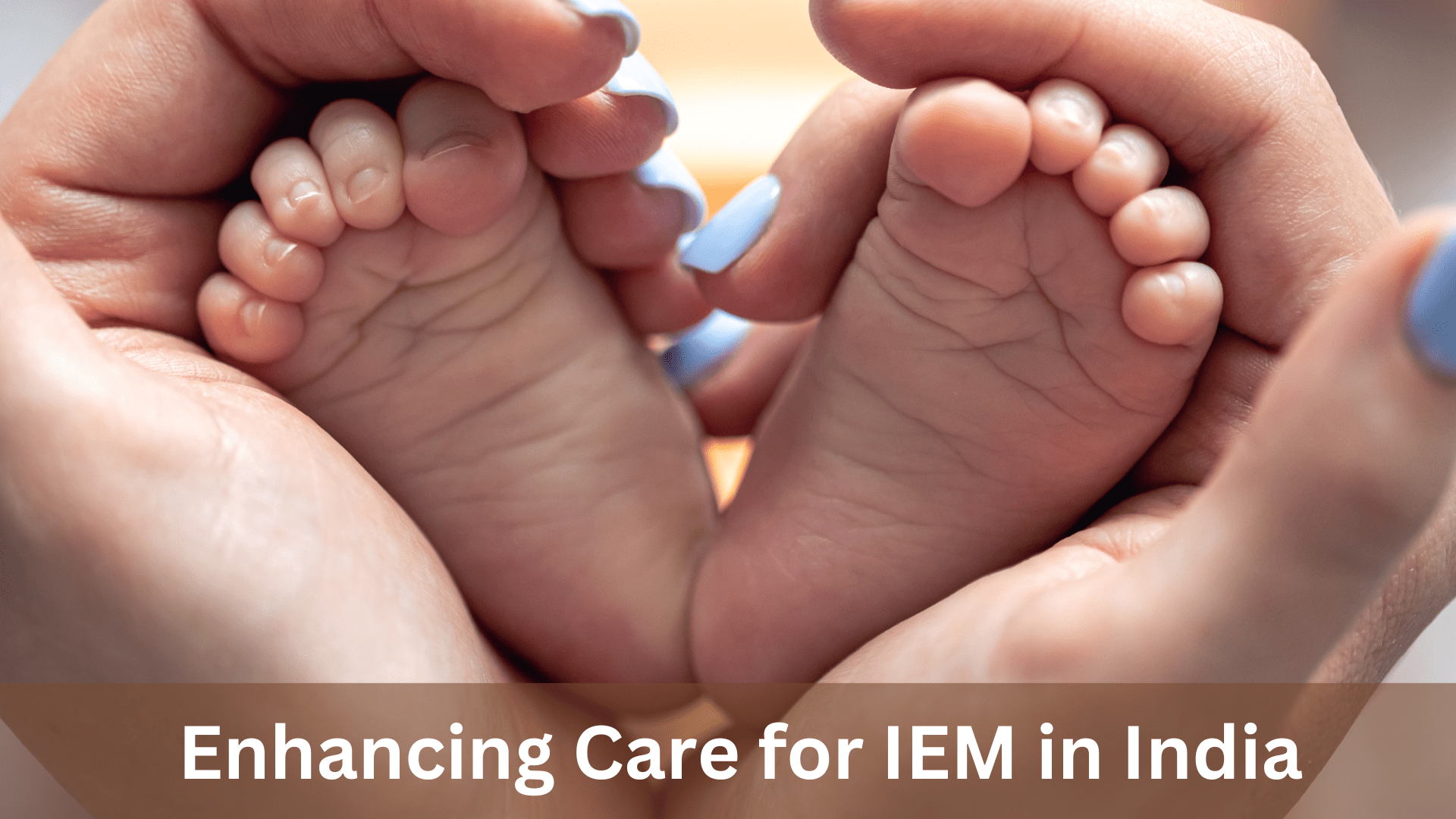What is IEM?
Inborn Errors of Metabolism (IEM) are rare genetic (inherited) disorders marked by deficiencies in the body’s capacity to convert nutrients into energy or essential components vital for proper growth and development. These conditions arise from gene mutations responsible for coding enzymes or proteins pivotal in diverse metabolic pathways.
IEMs can disrupt multiple metabolic processes, encompassing the breakdown of carbohydrates, proteins, and fats and synthesizing crucial molecules like amino acids and neurotransmitters. Consequently, individuals affected by IEM may manifest a broad spectrum of symptoms, ranging from developmental delays and intellectual disabilities to organ dysfunction, seizures, and metabolic crises.
These disorders are characterized by interruptions in metabolic pathways, leading to the accumulation of toxic substances within the body. While rare, IEMs can profoundly affect overall health and well-being, necessitating vigilant monitoring, early detection, and tailored interventions to mitigate their impact and optimize outcomes for affected individuals.
Types of IEM
1. Disorders of carbohydrate metabolism:
- Glycogen storage disease
- Glucose-6-phosphate dehydrogenase (G6PD) deficiency
2. Disorders of amino acid metabolism:
- Phenylketonuria (PKU)
- Maple syrup urine disease
- Glutaric acidemia type 1
3. Urea Cycle Disorder or Urea Cycle Defects:
- Carbamoyl phosphate synthetase I deficiency
- Citrullinemia type II (citrin deficiency)
4. Disorders of peroxisomal function:
- Zellweger syndrome
5. Lysosomal storage disorders:
- Gaucher’s disease
- Niemann–Pick disease
6. Disorders of porphyrin metabolism:
- Acute intermittent porphyria
7. Disorders of purine or pyrimidine metabolism:
- Lesch–Nyhan syndrome
- AMPD1 Deficiency (MADD)
8. Disorders of steroid metabolism:
- Lipoid congenital adrenal hyperplasia
- Congenital adrenal hyperplasia
9. Disorders of mitochondrial function:
- Kearns–Sayre syndrome
10. Disorders of organic acid metabolism (organic acidurias):
- Alkaptonuria
- Combined malonic and methylmalonic aciduria (CMAMMA)
- 2-hydroxyglutaric aciduria
11. Disorders of fatty acid oxidation and mitochondrial metabolism:
Medium-chain acyl-coenzyme A dehydrogenase deficiency (MCADD)
Most prevalent case of IEM in India
The prevalence of Inborn Errors of Metabolism (IEM) in India is reported to be 1 in 2497 newborns. Some of the most prevalent IEMs in India include congenital hypothyroidism, glucose-6-phosphate dehydrogenase (G6PD) deficiency, and amino acid disorders such as phenylketonuria (PKU) and maple syrup urine disease (MSUD). However, the true pan-India prevalence of IEM is still unknown, and more comprehensive data collected through universal screening of the low-risk population is essential to determine the accurate disease burden in the Indian population
Each year in India, there are approximately 24 million births. Among these, around 780,000 infants are born with congenital malformations, 340,000 with G6PD deficiency, 20,800 with metabolic disorders, 21,000 with Down syndrome, 10,400 with congenital hypothyroidism, 9,000 with thalassemia, and 5,200 with sickle cell anemia.
A hospital-based study in India conducted biochemical screening on 4,400 cases of mental retardation. The results showed that 5.75% of these cases (equivalent to 256 cases) were attributed to metabolic disorders.
Current status of IEM in India
In India, there is a rising emphasis on the identification and management of inborn errors of metabolism (IEM). A study conducted in South India presented a cohort comprising 33 newborns diagnosed with IEM, among whom 3 were identified through newborn screening, while 16 succumbed during the neonatal period or later stages.
Additionally, an IEM database in the Indian state of Andhra Pradesh catalogs information on 43 IEM disorders prevalent in the region, indicative of heightened awareness and recognition owing to enhanced healthcare infrastructure and laboratory diagnostic capabilities. However, prospective investigations to gauge the impact of IEM within the Indian populace are lacking, underscoring the imperative for further research and prospective evaluation to ascertain the burden of IEM nationwide.
A multicentric study published in 1991 by collaborating centers of the Indian Council of Medical Research (ICMR) highlighted metabolic aberrations as significant contributors to cases of mental retardation. Furthermore, a recent investigation from Maharashtra, India, delineated citrullinemia as a prevalent urea cycle defect, underscoring the spectrum of both common and rare IEM being identified across the country.
Severity of IEM
Among the severe forms of inborn errors of metabolism (IEM) are organic acidemias, phenylketonuria (PKU), maple syrup urine disease (MSUD), and urea cycle disorders.
Organic acidemia encompasses a range of conditions affecting the breakdown of amino acids and fatty acids, resulting in the accumulation of organic acids in the blood and urine. This accumulation can lead to severe metabolic acidosis, seizures, and developmental delays. Men exhibited a higher prevalence of organic acidemia at 53.8% compared to women at 46.2%. Consanguinity was observed in 84.7% of patients affected by this condition.
PKU is an autosomal recessive disorder that interferes with the metabolism of phenylalanine, causing its buildup in the blood and brain. This buildup can result in severe intellectual disability, seizures, and behavioral issues. The prevalence of PKU differs significantly across ethnic groups and geographical areas, impacting around 1 in 24,000 individuals globally.
MSUD is a rare autosomal recessive disorder affecting the metabolism of branched-chain amino acids, leading to their excessive presence in the blood and urine. This can manifest as severe neurological symptoms, including seizures, coma, and even death. MSUD occurs in approximately 1 in 86,800 to 185,000 live births
Urea cycle disorders, on the other hand, are a group of conditions impacting nitrogen metabolism, causing the accumulation of ammonia in the blood and brain. This accumulation can trigger severe neurological symptoms, such as seizures, coma, and potentially fatal outcomes.
In India, the estimated incidence rate of IEM is 1 in 540 individuals, with certain types like citrullinemia identified as prevalent urea cycle defects in specific regions.
Timely detection of these disorders through newborn screening tests is crucial, enabling prompt intervention and management. However, diagnosing and managing IEM presents significant challenges. The prevalence of these disorders in India underscores the necessity for ongoing research and public health initiatives to address this substantial healthcare burden.
Diagnosis pattern in India
In India, the diagnosis of inborn errors of metabolism (IEM) is shaped by several factors, including advancements in healthcare services, laboratory diagnostics, and the prevalence of consanguineous marriages. The reported prevalence of IEM in India shows that certain regions like Andhra Pradesh exhibit a higher prevalence, around one in 1000 newborns. Given India’s high birth rate of roughly 25 million babies annually, there’s a pressing need for prompt and accurate detection of IEM.
Screenings help to detect metabolic disorders, blood diseases, and genetic disorders, facilitating timely intervention and management. However, the adoption of newborn screening programs in India is still in its nascent stage, partly due to the associated costs of implementing advanced technologies.
The research underscores the importance of developing databases tailored to specific regions and ethnicities to better grasp the prevalence of IEM. For instance, the Database for Inborn Errors of Metabolism in the Indian State of Andhra Pradesh (DIEMISAP) provides valuable insights into the regional prevalence of IEM disorders in Andhra Pradesh.
The diagnosis landscape of IEM in India is further influenced by the burden of genetic disorders, including IEM, which significantly contributes to morbidity and mortality rates in the country. Despite the obstacles, there’s an increasing awareness of metabolic disorders fueled by enhancements in healthcare infrastructure and laboratory capabilities.
Newborn Screening For IEM
Newborn Screening (NBS) involves testing newborn babies’ blood for metabolic disorders, genetic diseases, and blood disorders. It detects Inborn Errors of Metabolism (IEMs) to prevent future health issues, sometimes even eliminating disorders entirely. Samples are taken from the baby’s heel within 24 to 48 hours of birth for optimal effectiveness. If initial tests show irregularities, further testing is conducted. Reports are then provided to the pediatrician or parents for treatment and counseling. NBS is mandatory in many countries globally.
Newborn screening for inborn errors of metabolism (IEM) in India involves several steps:
- Sample Collection: Within 24-48 hours of birth, a few drops of blood are collected from the baby’s heel onto a special filter paper.
- Transportation of Samples: The blood spot cards are transported to designated laboratories ensuring timely delivery and proper storage.
- Laboratory Testing: Dried blood spots undergo biochemical tests in equipped labs to screen for metabolic disorders using high-throughput technologies.
- Data Analysis and Interpretation: Abnormal findings are flagged for further investigation to establish a definitive diagnosis.
- Reporting and Follow-Up: Results are reported to healthcare providers and families. Abnormal results prompt referrals to specialized centers for evaluation, management, and genetic counseling.
- Quality Assurance: Quality control measures ensure accuracy through equipment calibration, proficiency testing, and adherence to standardized protocols.
These programs aim to identify IEMs early, enabling timely intervention and improving health outcomes.
Newborn Screening in India

In India, healthcare priorities primarily focus on reducing the Infant Mortality Rate (IMR) and meeting basic infrastructure needs. However, there’s yet to be a mandatory nationwide newborn screening program established by the Government of India or state and union territory governments.
Some healthcare centers in India offer mandatory newborn screening, while others provide it as an option for parents. Certain states and territories, such as Goa, Kerala, Chandigarh, Rajasthan (JK Lone Hospital, Jaipur), Tamil Nadu (Vellore), Greater Mumbai, and Delhi, have launched initiatives like Mission Neev to promote newborn screening.
Additionally, the Indian Council of Medical Research (ICMR) has mandated newborn screening for certain disorders. Projects like UMMID, undertaken by the Government of India, specifically focus on newborn screening. Furthermore, the Government of India has been emphasizing the importance of a rare disease policy, with draft policies giving significant importance to newborn screening.
India lacks a national newborn screening program. A pilot initiative funded by Grand Challenges Canada was implemented in Udupi district, South India, studying six selected disorders. Observations on disorder incidence were recorded, and a cost-effectiveness analysis was conducted. Results highlighted the significant financial loss from preventable diseases compared to screening costs, justifying the need for a national program.
The Rashtriya Bal Swasthya Karyakram (RBSK) aims to enhance children’s quality of life by providing comprehensive healthcare from birth to 18 years of age. It screens for four Ds:
- Defects at birth
- Diseases
- Deficiencies
- Development delays
It addresses 32 common health conditions. Convergence with other ministries facilitates screening, including at Anganwadi centers and schools. Newborns are screened at health facilities and during home visits by ASHA workers. The Ministry of Social Justice supports equipment for children with disabilities. Over 800 million children have been reached since 2014 through mobile health teams, working towards a healthier future for the nation.
NBS Cost and Condition
Some of the specific disorders that can be screened for through NBS in India include amino acid disorders, fatty acid disorders, organic acid disorders, endocrine disorders, and hemoglobin disorders
Costs for newborn screening have significantly reduced, with a basic screen for five common diseases now achievable for Rs 1000, and a more comprehensive one for about Rs 6000. A study on Congenital Adrenal Hyperplasia (CAH) newborn screening (NBS) in India revealed significant cost-effective
IEM Across Indian States
Newborn screening (NBS) for inborn errors of metabolism (IEM) in India varies significantly across states, lacking uniformity in implementation. While successful in many countries, NBS is not mandatory in India, leading to varied adoption rates and practices.
For instance, Chandigarh’s NBS program primarily operates in four urban government hospitals, screening approximately 15,000 births annually. Some states, like Goa, Kerala, Chandigarh, Rajasthan, Tamil Nadu, Mumbai, and Delhi, have launched initiatives like Mission Neev, incorporating NBS for IEM.
However, NBS implementation in India faces challenges such as limited awareness of IEMs among medical professionals, insufficient incidence data for universal screening advocacy, and inadequate physician training on IEMs and treatments. Consequently, the status of NBS for IEM diagnosis across Indian states lacks consistency and requires addressing various challenges for successful integration.
Strategies for Enhancing Newborn Screening
To establish newborn screening as a nationwide initiative in India, several critical steps must be taken:
- Government Policy and Support: The Indian government needs to prioritize and endorse the rollout of a national newborn screening program. This entails developing and implementing policies that mandate and financially support newborn screening for every newborn in the country.
- Awareness and Education: There’s a notable lack of awareness about inborn errors of metabolism (IEMs) among healthcare providers. Extensive awareness campaigns targeting healthcare professionals, policymakers, and the public are essential to underscore the importance of newborn screening and its potential public health impact.
- Regional Pilot Programs: Implementing pilot newborn screening programs in different regions can help assess the prevalence of IEMs and gather crucial data to support the case for universal screening.
- Infrastructure and Resources: Adequate healthcare infrastructure and resources must be made available nationwide for the diagnosis and treatment of IEMs. This requires investment in facilities and ensuring accessibility to necessary resources and expertise for newborn screening and subsequent care.
- Quality Assurance and Training: Laboratories conducting newborn screening must adhere to stringent quality assurance standards and undergo regular training in screening protocols and practices for healthcare professionals and laboratory staff.
- Budgetary Support: Historically, insufficient budget allocation has hindered the implementation of newborn screening programs. Increased funding and innovative financing mechanisms are necessary to support newborn screening initiatives adequately.
By addressing these key areas, India can lay the groundwork for a comprehensive and effective nationwide newborn screening program. Such an initiative would significantly contribute to the early detection and management of IEMs, ultimately reducing the burden of these disorders on public health.
Ramping Up Facilities:
COE hospitals and tertiary care centers must invest in cutting-edge diagnostic facilities for precise IEM detection, including genetic testing and advanced imaging. Establishing multidisciplinary teams comprising specialists like geneticists, pediatricians, and dietitians is essential for comprehensive patient care.
These centers should offer diverse treatment options, from dietary management to gene therapy, and facilitate access to orphan drugs. Patient education programs and support services are crucial for empowering families. Encouraging research collaborations and innovation is vital for advancing the understanding and treatment of IEM.
Conclusion
In summary, addressing the challenges surrounding the diagnosis and management of inborn errors of metabolism (IEM) in India requires a multifaceted approach. By investing in healthcare infrastructure, enhancing diagnostic capabilities, and establishing Centers of Excellence (CoE) with multidisciplinary care teams, we can significantly improve outcomes for patients with IEM.
Additionally, prioritizing patient education, supporting research initiatives, and advocating for increased budgetary allocation are essential steps toward achieving comprehensive care and bettering the lives of individuals affected by IEM. Through collaborative efforts and sustained commitment, we can pave the way for a brighter future in the diagnosis, treatment, and understanding of IEM in India.
Written By
Aswini PriyaMedical Content Writer
Reviewed By
Dr. AnchalMedico Expert
Last Updated
19 Feb 2024 | 03:40 PM (IST)










